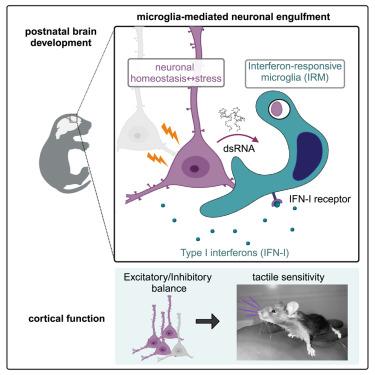Cell ( IF 64.5 ) Pub Date : 2024-03-14 , DOI: 10.1016/j.cell.2024.02.020 Caroline C. Escoubas , Leah C. Dorman , Phi T. Nguyen , Christian Lagares-Linares , Haruna Nakajo , Sarah R. Anderson , Jerika J. Barron , Sarah D. Wade , Beatriz Cuevas , Ilia D. Vainchtein , Nicholas J. Silva , Ricardo Guajardo , Yinghong Xiao , Peter V. Lidsky , Ellen Y. Wang , Brianna M. Rivera , Sunrae E. Taloma , Dong Kyu Kim , Elizaveta Kaminskaya , Hiromi Nakao-Inoue , Bjoern Schwer , Thomas D. Arnold , Ari B. Molofsky , Carlo Condello , Raul Andino , Tomasz J. Nowakowski , Anna V. Molofsky

|
Microglia are brain-resident macrophages that shape neural circuit development and are implicated in neurodevelopmental diseases. Multiple microglial transcriptional states have been defined, but their functional significance is unclear. Here, we identify a type I interferon (IFN-I)-responsive microglial state in the developing somatosensory cortex (postnatal day 5) that is actively engulfing whole neurons. This population expands during cortical remodeling induced by partial whisker deprivation. Global or microglial-specific loss of the IFN-I receptor resulted in microglia with phagolysosomal dysfunction and an accumulation of neurons with nuclear DNA damage. IFN-I gain of function increased neuronal engulfment by microglia in both mouse and zebrafish and restricted the accumulation of DNA-damaged neurons. Finally, IFN-I deficiency resulted in excess cortical excitatory neurons and tactile hypersensitivity. These data define a role for neuron-engulfing microglia during a critical window of brain development and reveal homeostatic functions of a canonical antiviral signaling pathway in the brain.
中文翻译:

I型干扰素反应性小胶质细胞塑造皮质发育和行为
小胶质细胞是大脑驻留的巨噬细胞,影响神经回路的发育并与神经发育疾病有关。多种小胶质细胞转录状态已被定义,但其功能意义尚不清楚。在这里,我们在发育中的体感皮层(出生后第 5 天)中发现了 I 型干扰素 (IFN-I) 反应性小胶质细胞状态,该状态积极吞噬整个神经元。在部分胡须剥夺引起的皮质重塑过程中,这个群体会扩大。 IFN-I 受体的整体或小胶质细胞特异性缺失导致小胶质细胞吞噬溶酶体功能障碍以及核 DNA 损伤的神经元积聚。 IFN-I 的功能获得增加了小鼠和斑马鱼中小胶质细胞对神经元的吞噬,并限制了 DNA 损伤神经元的积累。最后,IFN-I 缺乏导致皮质兴奋性神经元过多和触觉过敏。这些数据定义了神经元吞噬小胶质细胞在大脑发育的关键窗口期间的作用,并揭示了大脑中典型抗病毒信号通路的稳态功能。



























 京公网安备 11010802027423号
京公网安备 11010802027423号